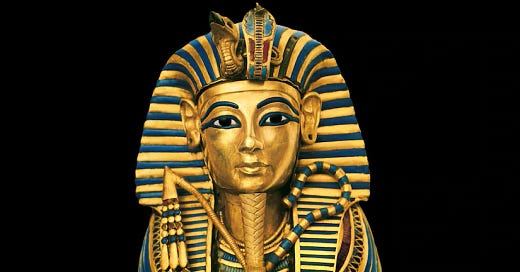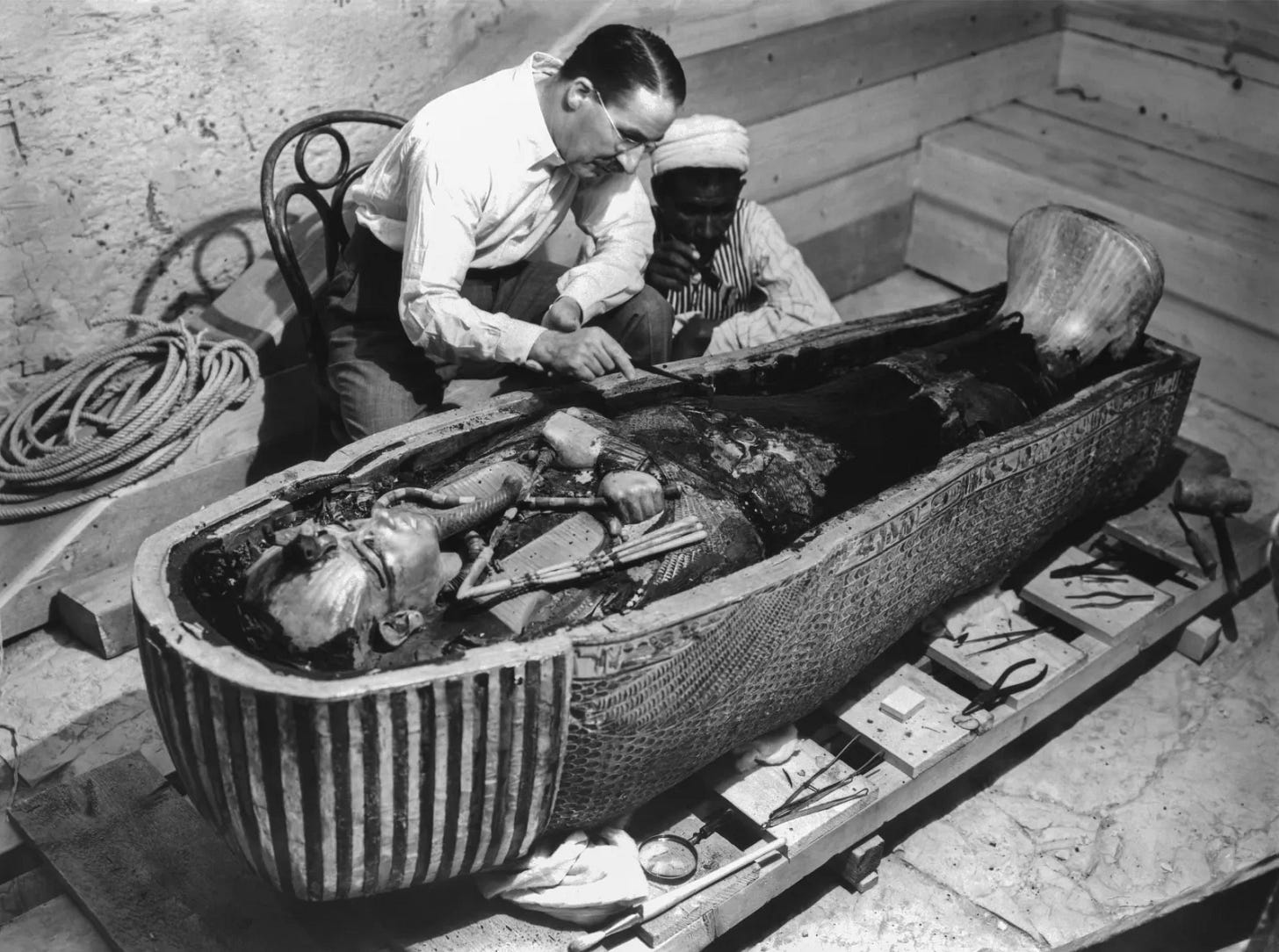King Tut: The Tomb That Founded Archeology
The entrancing story behind Ancient Egypt's Boy King.
King Tutankhamun is one of the most famous pharaohs of ancient Egypt. He was played by Steve Martin on SNL. King Tut’s tomb is among the greatest archeological discoveries of all time. Here is the enchanting story behind the mighty Golden King of ancient Egypt.
Ancient Egypt
Each year, fertile soil was left behind by the Nile River. From this sprung the civilization we call ancient Egypt. The Egyptians developed a flourishing culture, including an intricate religious belief system with many different gods. Temples were constructed, where the deities were worshipped by a professional class of priests. Kings officiated religious ceremonies.
Some temples, such as Luxor and Karnak, had an explicitly political function. Others were constructed as funerary structures designed to immortalize the memory of Egypt’s powerful pharaohs.
The afterlife
At the heart of Egyptian civilization lied a firm conviction in life after death. From this essential doctrine sprang forth their entire culture and way of life. The pyramids were constructed with the purpose of preparing for the afterlife. Spirituality united the Egyptians under a single national purpose.
Early in their history, more than 5,000 years ago, the Egyptians had a clear concept of an afterlife. They saw death as a continuation, and even an improvement upon, earthly existence. So they diligently prepared anything that might be useful for the afterlife, such as food, clothes, jewelry, furniture, as well as magical symbols and figures.
As burial rituals became more elaborate, the Egyptians perfected a system of making mummies. Bodies would be dried out in specific ways. Different styles and types of wrapping adorned the bodies. Jewels and amulets were buried alongside the deceased in the coffin.
Prior to the Old Kingdom period, embalmers started to remove certain parts of a dead body. They feared that their decay would interfere with the preservation of the body. Some organs, notably the brain, were discarded. The heart was mummified separately. The Egyptians wrongly believed that the heart, not the brain, was the seat of human consciousness. The lungs, liver, stomach, and intestines were embalmed. By the time of the Fourth Dynasty, burials began to include a separate chest for those organs.
Pyramids
The pyramids of Egypt were royal tombs designed to aid the King’s journey into the afterlife.
Early kings had smaller tombs, with flat roofs. Over time, Egyptian architects developed a stepped form of architecture. It was designed as a ladder reaching heaven, where the King could reside in perfect happiness with the gods former.
King Djoser’s Step Pyramid was history’s first-ever monument. It was constructed entirely out of stone. A generation or two later, the pyramid style that we know and love today evolved. The sides got smoothed out. Heights reached over 400 feet in the sky, which was utterly unprecedented.
The grand pyramids of Egypt was especially impressive to modern people, because they possess an architectural precision not seen even in modern-day construction projects. Each of the sides are almost exactly the same length, within less than an inch of each other. The monumentality and mathematical perfection of the Fourth Dynasty’s pyramids would never again be duplicated. They continue to leave even modern people, with all of our technology, in utter disbelief and awe.
Tomb raiders
Securing the treasures of the pyramids was an elaborate task. Traps were designed to capture any trespassers. Despite vast security measures, every single tomb was robbed. The Pharaohs tried everything to prevent this. They used blocking stones. But the shameless ostentation of these royal monuments was too irresistible to raiders.
Beginning in the Eighteenth Dynasty, the Kings of Egypt began to change tactics. They moved their royal cemeteries into the south, at the city of Thebes. They stopped building giant monuments, which made them less likely to be victimized. These hidden tombs were deliberately set up in barren wastelands, where no one would ever care to look. It was literally the land of the dead.
The Valley of the Kings provided the resting place for many of Egypt’s monarchs of the New Kingdom. Tombs were carved hundreds of feet into the bedrock. Despite the secrecy, even these tombs were robbed. Only one exception existed: the Tomb of King Tut.
King Tut
King Tut was born in the palatial capital of Amarna, which had been founded by his religious unorthodox father King Akhenaten.
Akhenaten’s religious reforms were deeply unpopular among the Egyptian people. This new faith, called Atenism, spoke nothing about death and the afterlife. It taught a grim doctrine of eternal oblivion, and denied any existence of a conscious afterlife. This spiritually bereft religion did not catch on with the Egyptian populace. To make matters worse, Akhenaten had styled himself as a messiah, who was singularly capable of mediating between humanity and the Sun God.
Little is known about the early life of young Prince Tutankhamun. Around the age of nine, he acceded the throne of Egypt. He formally adopted the name Tutankhamun, which venerated Egypt’s former deity Amun. The Boy King never reached his goal of completely restoring Egypt’s traditional religion, because he died unexpectedly at the age of 19. The cause of death is unknown, but recent CAT scans by National Geographic have debunked any claims of assassination. He may have died of poisoning, an unintended consequence of treating a leg ailment.
King Tut was probably too young for his tomb to have been completed at the time of death. With just 70 days, he was rapidly mummified. His inner organs were removed and preserved in separate containers. The coffin portrays King Tut as the Egyptian deity Osiris, with his arms crossed over the chest and holding the royal crook and flail. He was buried in a small makeshift tomb. This chamber was stocked with treasures beyond one’s wildest imagination, and was left undiscovered by anyone until the early 20th century.
Brits in Egypt
King Tut’s tomb was discovered by a 20th-century British Egyptologist named Howard Carter. Carter moved to Egypt in his late teens. A gifted artist, he used his talents to illustrate for some of the world’s leading field archeologists.
Carter eventually became an archeologist himself. He had a lifelong desire to excavate at the legendary Valley of Kings. The Earl of Carnarvon also took a fond interest in Egypt’s ancient history. The two men instantly became friends.
Carter and the Earl suspected that the Tomb of Tutankhamun was still to be found. Fragments from it had been discovered by an earlier excavator named Theodore Davis, who mistakenly believed that there was nothing else at the site.
Despite skepticism from Britain’s academic establishment, Carter and Lord Carnarvon began their own excavations. Using the labelled artifacts, Carter meticulously drafted out a map of the area. Season after season passed, but he could not find anything significant. Was he wrong? Carter must have been plagued by self-doubt. Even worse, his unsatisfying work was interrupted by the outbreak of WWI.
Howard Carter’s discovery
After the Great War, Carter resumed his quest to find Tut’s Tomb, but it continued to elude him. The Earl’s interest began to wane, and by 1922, he was ready to withdraw his support for the excavations. Carter rushed back to England to persuade his friend to continue the funds.
By early November, Carter had finally came upon what he was looking for. He found the first step of a 16-step staircase leading to the famed Tomb of King Tut. “At last, have made wonderful discovery in the Valley,” Carter telegraphed to his financial patron.
The discovery of King Tut’s tomb was just the beginning. It took almost ten years to photograph, record, conserve, pack and ship 5,000 artifacts from the tomb in southern Egypt toward the Cairo Museum in the north.
Carter’s discovery was a breakthrough in archeology. The Tomb of King Tut provided an indispensable window for modern eyes into the fascinating world of ancient Egypt. It contained not only the conspicuous consumption characteristic of New Kingdom pharaohs, but also many quotidian items such as food, clothing, furniture, and chariots. Religious amulets were there to protect Tut’s transition into the afterlife. Hundreds of items were found. Jewels adorned the King. Games were there for his amusement. Vessels were kept with precious ointments. Gold glimmered at every glance. To the ancient Egyptians, gold had a special religious significance. It was believed that the gods’ flesh was made of gold.
Tragedy struck soon after, leading to the myth of the so-called Curse of King Tut. Three months after the discovery, the Earl died. He did not live long enough to witness the Tomb’s ultimate prize: the coffin, golden mask, and mummy of King Tut himself.
Today, the legacy of King Tut’s tomb on the field of archeology is incalculable. It remains one of the world’s greatest historical finds, and continues to inspire interest and infatuation with the grand history of ancient Egypt.
Learn More






